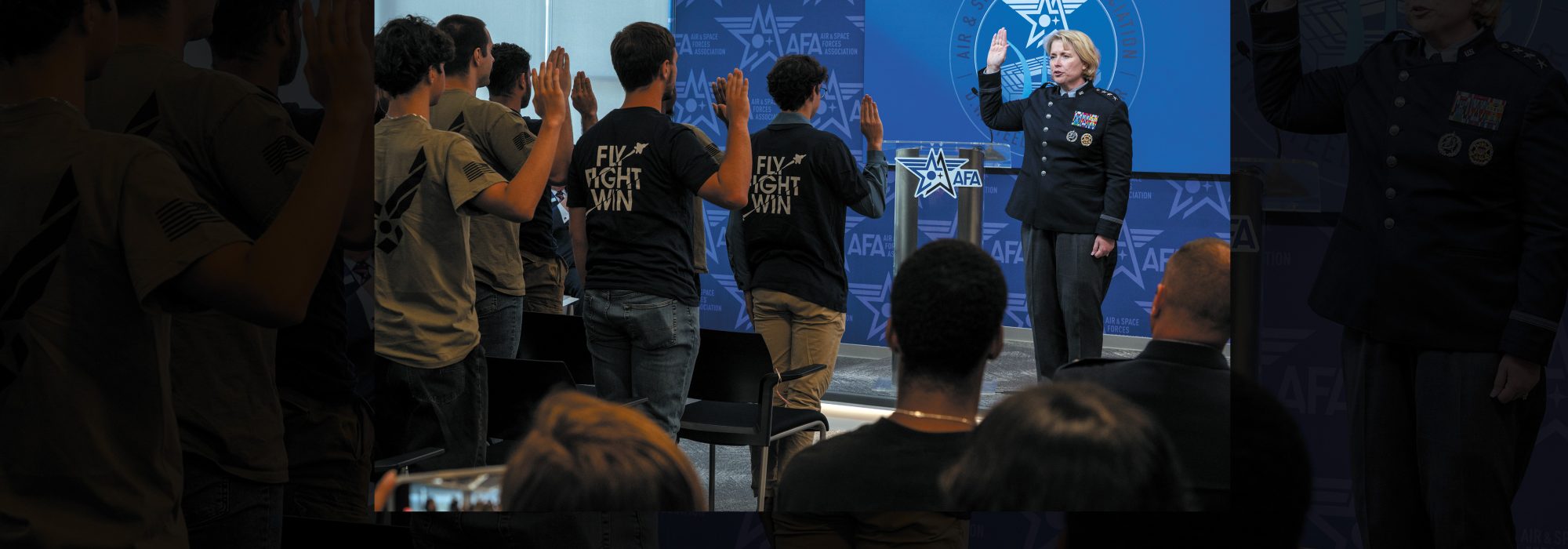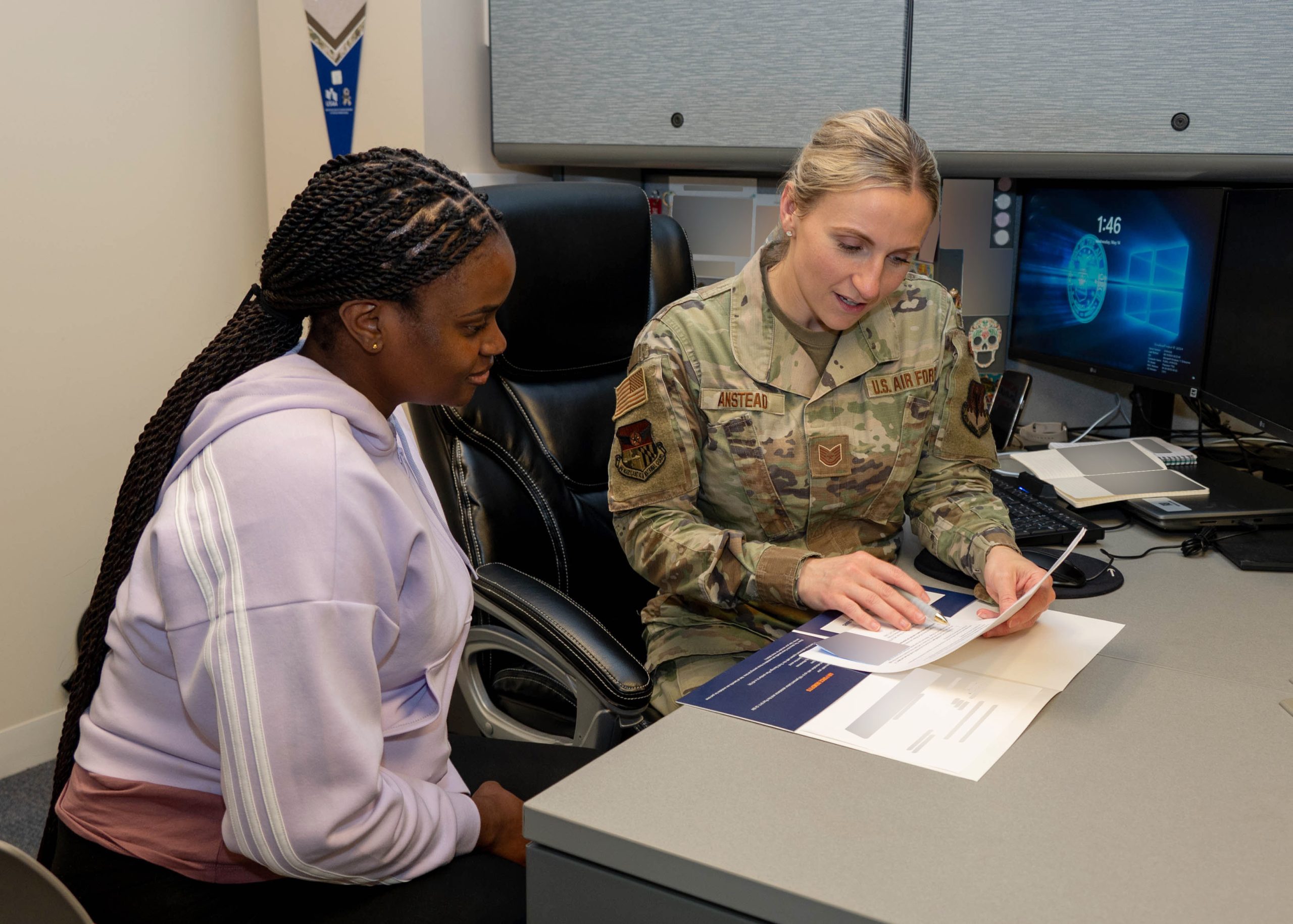USAF, USSF Hit Recruiting Goals—3 Months Early
By Chris Gordon
The Space Force and Air Force both hit their fiscal 2025 recruiting goals with months to spare, extending a promising trend that has boosted the services’ ranks.
The Space Force goal was 800 new enlisted Guardians this year, and the Air Force needed to enlist more than 33,000 Active-duty Airmen, plus 7,600 in the Reserve and 8,679 in the Air National Guard.
By June 30, the Air Force Recruiting Service said, the Department of the Air Force had “achieved 100 percent of its annual recruitment goal three months ahead of schedule.”
That includes some 30,000 recruits who will complete Basic Military Training by the end of September, and more than 14,000 recruits now in the Delayed Entry Program (DEP), the strongest figure in the past decade. The Air Force also said it had signed up a record 750 Special Warfare recruits.
“I am excited that both the Air Force and the Space Force have met their fiscal year 2025 recruiting goals three months early,” Secretary of the Air Force Troy E. Meink said in a statement. “The fact that we have even exceeded this goal and currently have a DEP at its largest level in 10 years speaks to the vast number of volunteers interested in serving their country today.”
For the Space Force, it is the sixth straight year it has hit its recruiting goals, meeting its target every year since its inception as a service. The Air Force has now hit its goals two years in a row.
“It’s clear Americans are excited about the Space Force, and this achievement is a direct reflection of the talent our mission continues to attract,” Chief of Space Operations Gen. B. Chance Saltzman said in a statement, praising the “high-caliber patriots” his service has signed on.
Space Force officials touted not only the quantity but the quality of the recruits. According to service data as of May 31, some 93.5 percent of Space Force recruits scored above average on the Armed Services Vocational Aptitude Battery (ASVAB), a mandatory test given to those seeking to serve in all U.S. military branches that determines which jobs the recruit qualifies for.
One in five recruits holds some form of college degree, and 12.9 percent have at least a bachelor’s degree, according to USSF officials.
The Air Force Recruiting Service (AFRS) handles recruiting for the Space Force, as one of the support functions the Air Force provides its sister service. However, AFRS has established a dedicated squadron of Guardian recruiters as the Space Force continues to carve out its own culture, and its mission and ranks continue to expand.
“I’m grateful to the incredible recruiters whose tireless dedication made this milestone possible,” Chief Master Sergeant of the Space Force John Bentivegna said in a statement.
Bentivegna also showered praise on the USSF recruits, saying, “Each one reflects the very best of our nation, and their decision to serve speaks volumes about the talent, drive, and potential they bring to our mission.”
Air Force Chief of Staff Gen. David W. Allvin touted “record recruitment” in a statement. “The Air Force invests in our Airmen and patriotic Americans ready to serve have noticed and are lining up and signing up,” Allvin said. “That’s evident with the largest number of Special Warfare candidates awaiting training on record and the throngs of recruits motivated to start basic military training. We’re thrilled to welcome these warriors into our Air Force!”
New Recruiting Task Force Looks to Build on Recent Gains
By Rachel S. Cohen
As the U.S. military enjoys a resurgence in interest among potential recruits, a new Pentagon task force will try to build on that momentum.
The Military Service Recruitment Task Force, established June 13 by Defense Secretary Pete Hegseth, aims to woo a new generation of service members with a fresh, unified message and new ways to expand the pool of eligible Americans.
The task force is the latest initiative to encourage young Americans to enlist after a rocky few years prompted concerns about whether the 52-year-old all-volunteer force could survive a second half-century.
“Changing environmental factors demand a targeted and strategic approach to strengthen recruiting efforts across the department,” Hegseth wrote in a memo creating the task force.
Jay Hurst, the Defense Department’s acting personnel boss, and Chief Pentagon Spokesperson Sean Parnell will co-chair the panel. Public affairs, marketing, and recruitment experts from each service will weigh in, as will the Pentagon’s top legislative affairs official and its general counsel.
The team is asked to assess the current recruiting landscape within 30 days; propose policy and legislative changes to address those challenges within 60 days; and draw up a communications plan to support the armed forces and the Pentagon’s internal polling office, which tracks public sentiment about military service, within 90 days, the memo said.
Hegseth hopes to capitalize on the Navy and Marine Corps’ 250th anniversaries this fall as major recruiting events, as well as America’s own semiquincentennial in July 2026. The Army did not respond to a query on whether it has seen a spike in interest following its 250th birthday parade in Washington June 14.
The share of Americans who know someone in uniform has dwindled since the 1990s, diminishing young people’s familiarity with military life and, by extension, their propensity to serve.
Recreational drug use, criminal convictions, and common prescription medication for conditions from attention deficit disorder to asthma have also been barriers. Even basic health and physical fitness can be barriers to entry. Many would-be recruits can’t qualify under health and weight standards. Nearly eight in 10 Americans between the ages of 17 and 24 would need a waiver to join because they would otherwise be disqualified from service, the Pentagon said in October.
Under the last administration, the military attacked the downturn by loosening some standards, including body fat limits and bans on neck and hand tattoos. The Army launched a preparatory program to help potential recruits meet both academic and physical standards. The Air Force added recruiters to reach more prospects.
Hegseth cited a different reason: “Because of President Trump and his ‘America First’ priorities, recruitment and retention under this administration are higher than they’ve been in decades,” Hegseth told House lawmakers June 12.
Data shows recruitment was rebounding even before the 2024 presidential election, however, as 12.5 percent more people signed up in fiscal 2024 than in the previous year. Every military service but the Navy met their accession goals for 2024.
This year, all six branches of the armed forces have already met or appear on track to hit their recruiting goals. However, the Army and Navy met their numbers by lowering quality benchmarks, something the Air Force has not had to do.



